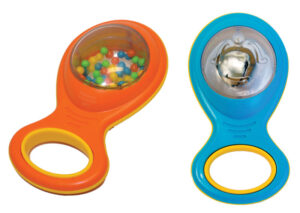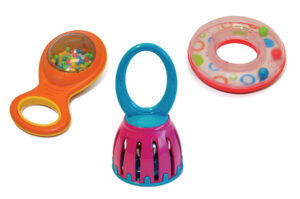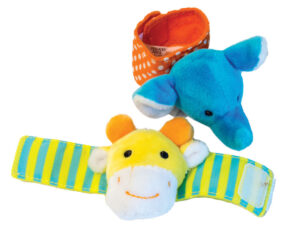Fine motor development
An infant watches a caregiver make sounds by shaking a toy, with the opportunity to hold and shake a sound-making toy.



[Sit on the floor facing an infant who is on his/her back or tummy. Place the infant on his/her back if the infant is not able to push up with his/her arms and holds its head/neck.
If the infant is on his/her back: Hold the rattle in one of your hands and the bell in your other hand. Hold the two toys near the center of the infant’s chest within easy reach of the infant and within the infant’s line of vision. Do not place either of the toys in the infant’s hand without first providing a sustained opportunity for the infant to reach for one or both of the toys. 
If the infant is on his/her tummy: Place the rattle and the bell directly in front and within easy reach of the infant.
Gently move the toys as you present each, one at a time as suggested below. Point to your ear when you say “hear.”]
Here is a rattle. Listen. Do you hear the sound of the rattle?
Shake, shake, shake. I am shaking the rattle. The rattle is making a sound.
Here is a bell. Listen. Do you hear the sound of the bell?
Shake, shake, shake. I am shaking the bell. The bell is making a sound.
Do you want to shake the rattle? Do you want to shake the bell?
[Encourage the infant to hold the bell or rattle with either hand. Shake the rattle or bell slightly if the infant does not look at the toys you offer. Depending on the infant’s motor development, he/she may or may not reach for the toy you offer.
Invite the infant to shake the toy(s) he/she is holding. Offer a demonstration by gently shaking a toy, if appropriate.]
[Describe the infant’s actions. Examples: “You looked at the bell and at the rattle. You smiled when you heard the sound of the bell. You are holding and shaking the bell. You are smiling when you shake your bell.” “You are shaking the bell in one hand and holding the rattle in your other hand.”
Allow the infant to simply hold or mouth the toy if he/she likes. If the infant is not holding both of the toys, take the toy not being used by the infant and shake it. Describe what you are doing and the sound you are making. Ask the infant if he/she would like to shake his/her toy.
Offer the infant the toy you are holding and shaking. Provide an opportunity for the infant to reach for the toy rather than immediately putting it in his/her hand.
Describe the infant’s vocalizations. Example: “You are laughing. You are laughing while you shake your bell.”]
We went shake, shake, shake with a bell and a rattle today. We heard the sound of a rattle and the sound of a bell.
At this age, an infant may be engaged for a few seconds or may be interested in the sound making and interaction for several minutes. Be attentive to the infant’s reactions to the sound of a toy. The infant may turn away or fuss if the sound is displeasing. If an infant prefers the sound of one toy over another, describe the infant’s preference. Example: “I think you like the sound of the bell. We can put down the rattle for now.” Welcome mobile infants who want to join you but be careful to not share toys that an infant has mouthed. Remember that an infant’s interest in the activity is supported when you convey it is both interesting and enjoyable.
Extra support
Enrichment
Fine motor development
An infant shakes different types of sound-making toy(s) with caregiver guidance.



Sit on the floor facing an infant  who can sit with support or sit independently. Put the three toys on the tray with sufficient space between each so the infant can clearly see each item. Place the tray of toys in front of you. Gently shake each item as you say its name and your action. Example: “This is a bell. I am shaking the bell. The bell is making a sound. This is a rattle. I am shaking the rattle. Listen to the sound the rattle is making. This is a ring. The ring makes a sound when I shake it. Shake, shake, shake. Our toys make a sound when we shake them.”
who can sit with support or sit independently. Put the three toys on the tray with sufficient space between each so the infant can clearly see each item. Place the tray of toys in front of you. Gently shake each item as you say its name and your action. Example: “This is a bell. I am shaking the bell. The bell is making a sound. This is a rattle. I am shaking the rattle. Listen to the sound the rattle is making. This is a ring. The ring makes a sound when I shake it. Shake, shake, shake. Our toys make a sound when we shake them.”
Hold the tray of toys near the center of the infant’s chest. This provides an opportunity for the infant to practice reaching and grasping one or more of the toys. Encourage the infant to take one or more of the toys and to shake each toy he/she takes.
Describe the infant’s actions. Examples: “You looked at the bell, the rattle, and
the ring. You picked the (name of toy) to hold and move.” “You are shaking the
ring and making a sound.” “You moved the rattle from one hand to another
hand.”
Take a toy not being used by the infant and shake it. Describe what you
are doing and the sound you are making. You may wish to shake the toy in
different ways (up and down, all around, side-to-side) but do not expect the
infant to follow your pattern. Be sure to return the toy to the tray so the infant
can hold it and maybe shake it. Draw attention to differences in the sounds of
the toys.
Watch for opportunities to show and describe how moving a toy with our hand can make a sound. If an infant shows interest in the ring, point to and name the beads inside the ring. Show how the beads move and make a noise when the ring is moved. Encourage the infant to move or shake the ring while watching the beads move around. This is another way to help an infant begin to understand that his/her action produces the sound. Although you may move a toy in different ways, as suggested in the activity description, remember that your role is to support the infant’s movement of a toy with his/her hand, not to entertain the infant with your own actions.
Extra support
Enrichment
Fine motor development
An infant participates with a caregiver in shaking a
sound-making toy with one or two hands.



Be Prepared: One bell and one rattle are for the infant’s use. One bell and one rattle are for your use.
Sit across from an infant who can sit alone. Place one bell and one rattle on the small tray. Encourage the infant to take one of the sound makers. Use the same type of sound maker the infant uses. Put the other sound makers (yours and the infant’s) on the floor behind you. Use your same toy to imitate the actions of the infant. Describe the sounds. Example: “Our bells are ringing, ringing. You are shaking your bell to make it ring. I am shaking my bell to make it ring.”
Sing a song that supports the infant’s actions with the toy. See the following suggestion. Include the child’s name in the song and gently shake your same toy as you sing. (Tune: “Wheels on the Bus”)
Riana shakes a bell with one hand;
With one hand, with one hand.
Riana shakes a bell with one hand;
He/she makes a happy sound!
Lightly touch the infant’s opposite hand. Ask the infant, “Would you like to move the (name of toy) with your other hand?” Demonstrate and describe the movement of your toy from one hand to another hand. Then say to the infant, “Let’s try the other hand. I will sing a song for you.” Gently move the infant’s toy from one hand to the opposite hand if the infant seems interested in moving the toy to his/her other hand. If the infant is not interested in switching the toy to a different hand, acknowledge his/her wish. Example: “I think you want to hold your toy where it is. That’s fine.” Repeat the song you offered earlier in this activity. Encourage the infant to move the rattle or bell as you sing.
Although this activity mostly supports fine motor development, an important gross motor action is involved in securing the toy. Pay close attention to whether the infant has the body strength and balance to reach for the toy. The infant must sit and lean forward to reach the toy and return to a sitting position unless you provide the toy to him/her (see Extra Support tip).
Look for opportunities to emphasize how movement of the infant’s hand is what makes the toy make a sound, as suggested in the plan description. One of the ways this option is more challenging than Option 2 is the involvement of four toys (two of each type) for the infant to notice. The activity plan suggests moving toys not being used behind your back to help the infant focus on one type of toy being manipulated.
Extra support
Enrichment
 Materials Needed: wrist rattles; sound makers, such as bells or rattles
Materials Needed: wrist rattles; sound makers, such as bells or rattles
Young infants who do not sit independently will enjoy wrist rattles. Fasten the wrist rattle to an infant’s arm. Encourage the infant to move his/her arm by talking, smiling, and looking at the infant. Describe the sound. Example: “Your rattle makes a sound. Shake, shake, shake.” Talk with the infant about the sound his/her wrist rattle is making.
Place sound makers on a low table where mobile infants can discover them. Sit nearby so you can talk with the infants and join them in making sounds with a bell or rattle. As you shake the bell or rattle say, “My rattle makes a sound. Shake, shake, shake.”
Materials Needed: things in your setting that make sounds, such as a box of cereal or pasta, set of measuring spoons, crumpled paper
If older children are interested in the sound-making activity, suggest they listen while you and the infant make sounds. Ask the older children to describe how the sound is being made (by moving our hands). Later, take children on a walking tour of your home to find things that make sounds when you move or touch them. Examples: box of cereal or pasta, set of measuring spoons, crumpled paper. As you touch or move each item, comment on how you are moving the item and the sound it makes. Example: “I am moving this paper. This paper makes a crunch, crunch sound.” Point out how moving an item with your hand (and maybe your arm) makes the sound.